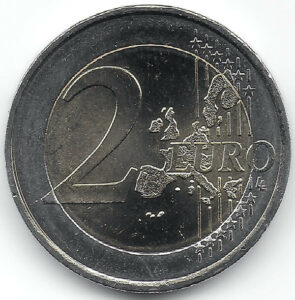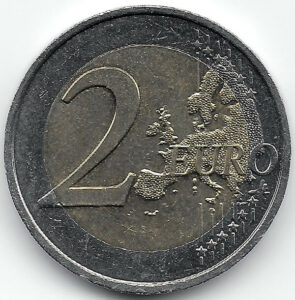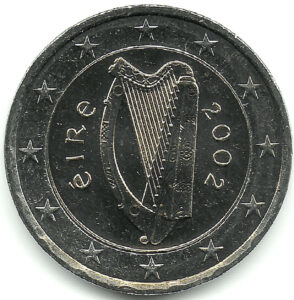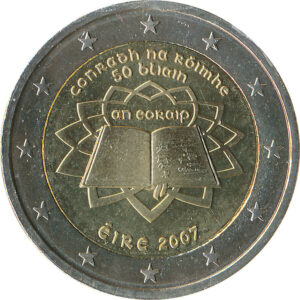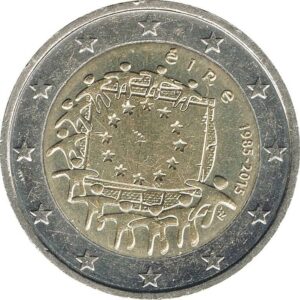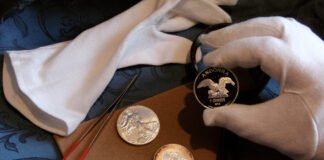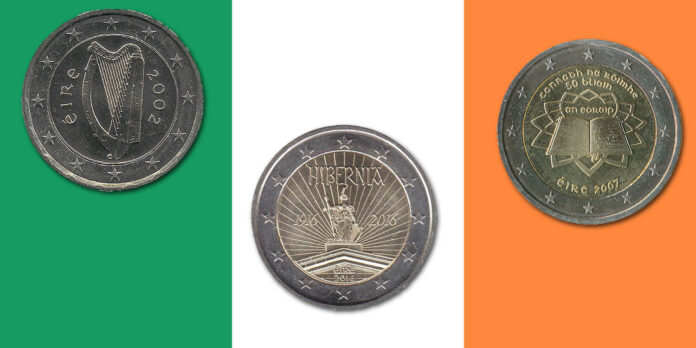
The Celtic harp was featured on Irish coins as early as the 16th century, and still today all euro circulation coins carry this symbol, without exception. Unfortunately, it happens ever so rarely that one comes across a numismatic representative of the green island in one’s wallet. 2 euro commemorative coins are equally rare to find around here. Collectors are well advised to resort to the secondary market straight away. Luckily the Republic of Ireland’s policy of issuing coins has been fairly moderate. And one other thing: If you’re looking to find a mint mark on any of Ireland’s 2 euro coins, you’ll be looking in vain.
2 Euro Circulation Coins
The Republic of Ireland was one of the countries to introduce the euro as its sole currency in 2002. The reverse design (RV) meets the requirements for all euro countries. The obverse design (OBV) depicts a Celtic harp. Euro coins have been minted in Ireland since 2002. All coins are produced by the Irish Mint in Dublin-Sandyford.
Just like 2 euro commemorative coins, all 2 euro circulation coins consist of a ring made of cupronickel. The core is made of nickel brass with a nickel core (CuNi / Ni, CuNiZn plated). All pieces can slightly be attracted by a magnet at the centre.
Technical Specifications
- Weight: 8.50 g
- Diameter: 25.75 mm
- Reeded edge
- All Irish coins feature the inscription “2” followed by two alternately inverted stars next to the reeded edge.
Particularities
Coloured or even gilded pieces are not official issues. They have been doctored and lost their former value as currency. In 2002, a mix-up of the dies affected some of the coins. The coins (number unknown) feature the edge inscription “GOD ZIJ MET ONS,” which is actually designed for Dutch pieces.
Mint Error Coins
Only minor punching errors are known to date. Do pay attention to die cracks and rotated dies though. Don’t be tempted to buy what are allegedly error coins on the internet at exorbitant prices! So, hands off and save some money.
Appraisal
The coins are occasionally found in circulation. On the secondary market, prices for mint state specimens range between 4 and 8 euros. Minor punching errors are between 10 and 25 euros. If you find a specimen with an incorrect edge inscription, you’re a lucky man. Although such specimens do exist, they have not yet been traded. You can expect a collector’s price.
Joint Issues of the Eurozone
Ireland participated in all four joint issues of the Eurozone of 2007, 2009, 2012 and 2015. So far, no mint error coins have been found. These pieces are hardly ever found in circulation. On the secondary market, the prices for mint state specimens range from 8 to 10 euros.
Technical Specifications
The technical specifications correspond to those of a 2 euro circulation coin.
To date only two 2 euro commemorative coins have been issued in addition to the joint issues of the Eurozone.
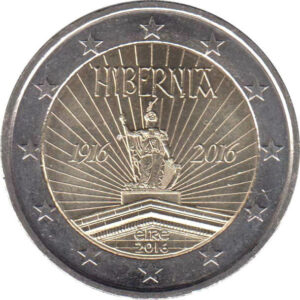
100th Anniversary of the Easter Rising, 2016
Ireland already tried to gain independence in 1916. Although the rebellion of militant groups was unsuccessful at the time, the year 1916 is remembered as an important turning point in the fight for independence. The OBV shows a statue, located on the rooftop of the General Post Office in Dublin. The statue with the Latin name “HIBERNIA” (Ireland) is a particularly important symbol of Ireland.
Technical Specifications
The technical specifications correspond to those of a 2 euro circulation coin.
Particularities
Coloured or even gilded pieces are not official issues. They have been doctored and lost their former value as currency.
Mint Error Coins
So far, no mint error coins have been found. Nevertheless, keep looking for minor punching errors, die cracks and rotated die error coins.
Appraisal
These coins can hardly be found in circulation. On the secondary market, prices for mint state specimens range between 7 and 14 euros.
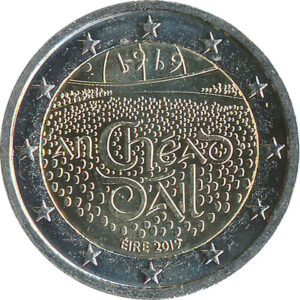
100th Anniversary of the First Dáil Éireann, 2019
On 21 January 1919 the revolutionary powers in Ireland convened for their first assembly (Irish = An Chéad Dáil) at the “Mansion House,” the seat of the Lord Mayor of Dublin. This day is extremely important in the history of Ireland. The OBV shows the year 1919 on top and below the words “An Chéad Dáil.”
Technical Specifications
The technical specifications correspond to those of a 2 euro circulation coin.
Particularities
Coloured or even gilded pieces are not official issues. They have been doctored and lost their former value as currency.
Mint Error Coins
So far, no mint error coins have been found. Nevertheless, keep looking for minor punching errors, die cracks and rotated die error coins.
Appraisal
These coins can hardly be found in circulation. On the secondary market, prices for mint state specimens range between 5 and 7 euros.
Ireland: The Perfect Introduction to the Euro-World
Due to their manageable number, Irish commemorative coins make for an ideal introduction to collecting euro coins by countries. With between 1 and 5 million pieces, the mintage is often low, making all specimens attractive for collectors. Although the mintage for circulation coins was initially higher, they are still hard to find in circulation. It is conceivable that prices for the four joint issues of the Eurozone in particular will rise a good deal. Equally possible is an increase in value for the 2012 issue (mintage: 1,350,000) and for the 2015 issue (mintage: 999,000).
In the online database Cosmos of Collectibles, you can find all Irish 2 euro coins.
And if you do not want to miss out on any Irish (or other) new issues, subscribe to the Cosmos of Collectibles newsletter, which is published every fortnight.
The author numiscontrol has already dealt with the rarities among 2 euro commemorative coins of other countries. too. Here you can read his articles for the coins from
- Finland, and
Particularly valuable are euro coins with “turning stars”, here you find out which pieces are worth several thousand euros.
Find out more about our author numiscontrol, alias Reiner Graff, in our who’s who.
The collecting expert made it his mission to introduce beginners to the world of coin collecting – here you can read his series “Coin Care in Simple Terms”.
And here you can find his series on rare 2 euro pieces from Germany and on the joint EU issues (in German).



